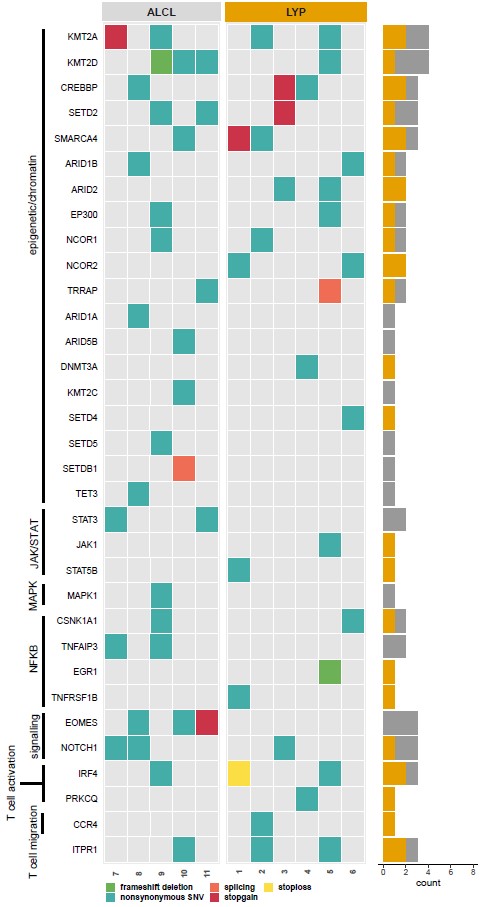Abstract
Primary cutaneous CD30+ T-cell lymphoproliferative disorders (CD30+ LPD) are the second most common cutaneous lymphomas. According to the World Health Organization (WHO), CD30+ LPD include primary cutaneous anaplastic large cell lymphoma (pcALCL) and lymphomatoid papulosis (LyP) as well as borderline lesions. pcALCL and LyP is thought to represent two ends of a spectrum of diseases that have different clinical presentations, clinical courses, and prognoses in their classic forms, but share the same histology of medium to large CD30+ atypical lymphoid cell infiltrates. Because the behavior of these entities is different clinically and prognostically, we aim to search for oncogenic genomic variants using whole exome sequencing (WES) that drive the development of LyP and pcALCL.
Clinical information, pathology, immunohistochemistry, and T-cell rearrangements on six cases of LyP and five cases of pcALCL were reviewed to confirm the rendered diagnosis prior to WES of all specimens. All cases of CD30 LPD had recurrent mutations in at least one of the epigenetic modifying genes, with the most frequent mutations found in the mixed lineage methyltransferase family involved in the methylation of H3K4: CREBBP (27%), KMT2A (36%), KMT2D (36%), SETD2 (27%), and SMARCA4 (27%) (Figure). Within the JAK/STAT pathway, mutations of STAT3 were observed in 2 cases of pcALCL (n=2, 18%), STAT5B in one case of LyP (n=1, 9%) and JAK1 mutation in one case of LyP(n=1, 9%). Lastly, mutations were also identified in the T-cell signaling pathway. 3/5 cases of pcALCL demonstrated loss of function mutations in EOMES, a T-box transcription factor important in lymphocyte development. We had two cases of C-ALCL and one case of LyP with NOTCH1 mutations supporting the importance of this gene in T-cell lymphomas.
TP53 mutations and copy number loss is more characteristic of aggressive lymphomas and these abnormalities were absent in pcALCL and LyP and may explain the indolent nature of CD30+ LPD.
While the JAK/STAT pathway, T-signaling, and epigenetic alterations possibly play a role in the pathogenesis of these diseases, genes involved in cell-cycle control and apoptosis (ie. TP53) that are characteristic of more aggressive diseases were not identified. Extending this investigation to a larger number of samples will allow us to detect additional mutations that may help distinguish between CD30+ LPDs of LyP and pcALCL as well as other histologic mimics such as systemic ALCL and large cell transformation of MF.
Abdulla: Caris Life Licenses: Current Employment. Zain: Kiyoaw Kirin, Secura Bio, Seattle Genetics: Honoraria; Secura Bio, DaichiSankyo, Abbvie: Research Funding; Secura Bio, Ono , Legend, Kiyowa Kirin, Myeloid Therapeutics Verastem Daichi Sankyo: Consultancy.


This feature is available to Subscribers Only
Sign In or Create an Account Close Modal